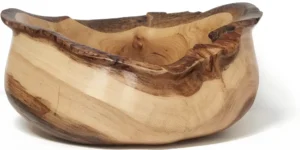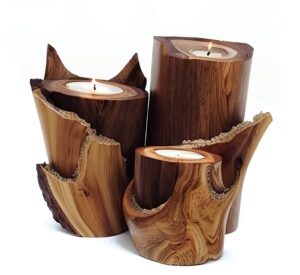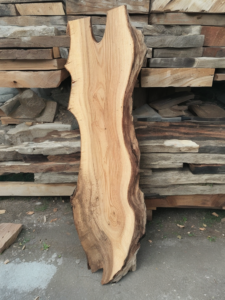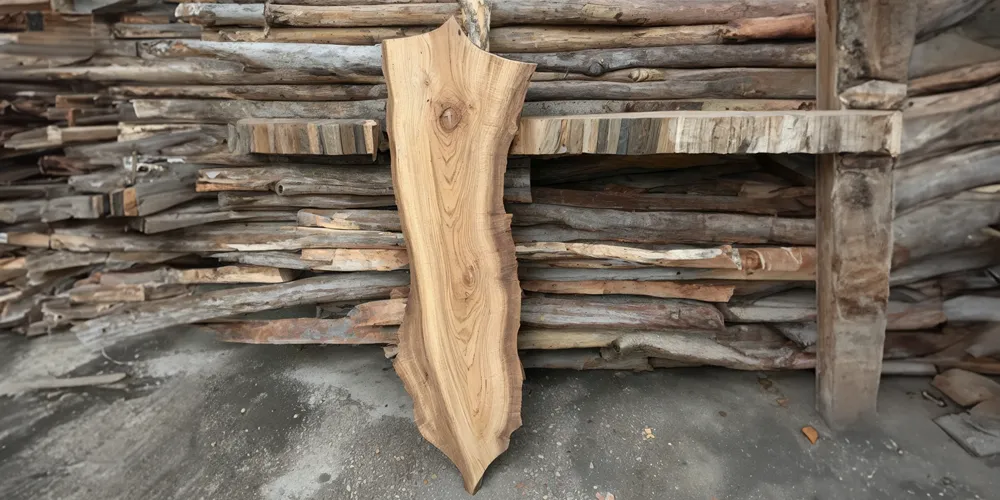So what is live edge wood? Why do you keep seeing this term passed around for tables, doors, or evern dinnerware? It seems to be everywhere!
Using live edge wood for a unique and increasingly popular woodworking technique has blown up in the last decade. Live-edge wood has captured the attention of both furniture enthusiasts and lumber yard business owners alike. By retaining the natural edges of a tree, live edge wood provides an organic, raw and natural aesthetic to any project. This can be incorporated into various styles for furniture, art, and decor pieces.
In this blog post, we talk about the reasons behind live edge wood’s growing popularity as well as what it’s used for. Explore the types of furniture created using these techniques. We will also discuss the milling process involved in creating live edge slabs and some popular wood choices.
As you continue reading, you’ll discover how to combine modern aesthetics with a live-edge rustic charm. It’s important to note that almost all live edge wood is put in wood dry kilns to be kiln dried. After reading this blog, you’ll gain a comprehensive understanding of what is live edge wood and how it can enhance your lumber business or personal woodworking projects.
Table of Contents
What is Live Edge Wood?
Live edge wood is lumber that retains the natural contours of the tree trunk, including bark and irregular edges. This is used for furniture making, art, and even dinnerware due to its unique appearance and connection to nature.
The Popularity of Live Edge Wood
Live edge wood is becoming increasingly popular, and it’s easy to understand why. It offers a fashionable look and it will last for years to come.
Reasons behind the growing trend for live edge designs
- Design: The natural beauty of live edge furniture adds a unique natural look to any space.
- Unique: Every live edge wood slab is completely unique to another.
- Versatility: Live edge pieces can fit into many interior styles. Rustic homes and modern decor mix well with live-edge designs.
Popular types of furniture made from live edge wood
- Live Edge Tables: Dining tables, coffee tables, side tables, or console tables with distinctive natural edges on one or both sides.
 Live Edge Dinnerware: Bowls, plates, forks, spoons, or even placemats. This design lends to a special experience at the dinner table.
Live Edge Dinnerware: Bowls, plates, forks, spoons, or even placemats. This design lends to a special experience at the dinner table. Live Edge Decor: All nick-knacks, decorations, and functional items in or around your home can come in a live-edge design.
Live Edge Decor: All nick-knacks, decorations, and functional items in or around your home can come in a live-edge design.
Live edge wood furniture is a great way to bring the beauty of nature into your living room, and it’s a trend that’s here to stay.
Crafting with Live Edge Wood
Craftsmen work hard to maintain the organic look of raw slabs while transforming them into functional pieces of furniture. You’ll find live-edge designs for things like tables, chairs, shelves, countertops, desks, lighting fixtures, and even bedroom sets.
One reason why live edge furniture can be expensive is that it requires more skillful milling compared to traditional techniques. Also, most milled lumber is dimensional lumber.

What is Live Edge Wood? A Really Cool Way To Use Kiln Dried Lumber.
Challenges Faced When Working With Live-Edge Materials
- Finding the right slab: The first challenge in working with live edge wood is finding a suitable slab. A live edge that showcases the tree’s natural edges while also being structurally sound for use in furniture construction.
- Milling and shaping: Milling live edge slabs requires precision and expertise. Each slab of wood has its own unique shape and grain pattern.
- Drying process: Properly kiln drying live edge slabs prevents warping or cracking. A dry live edge wood slab is a stable one.
Techniques Used by Artisans for Crafting These Unique Pieces
- Selecting complementary materials: Artisans often combine different types of lumber or incorporate other elements such as metal bases, acrylic material, or glass inserts into their designs.
- Matching wood to projects: Most of these live-edge pieces are commissioned, so a craftsman can help select the right size and wood for you. This is how the piece of wood turns out perfect for your table or desk.
- Working with lumber mills: Many skilled woodworkers get to know the saw mill companies pretty well. Many times you’re getting a discount on your live-edge decor without realizing it.
Choosing the Right Lumber for Your Project
Don’t be a wood sapling – selecting the right lumber is key to creating stunning live edge wood furniture that will last.
Factors Influencing Lumber Selection
- Color: Consider the natural coloration of the wood and how it will look when stained or finished.
- Durability: Choose a wood species with appropriate strength and resistance to wear and tear based on its intended use.
- Moisture: Opt for low moisture content below 15% in general. Dry wood is stable and won’t bend, warp, or twist on you.
- Budget: Keep costs in mind when selecting from popular wood species.
Popular Wood Species Suitable for Live-Edge Projects
Get ready to branch out with these popular choices:
- Black Walnut: A go-to choice thanks to its rich coloration and attractive grain patterns.
- White Oak: A beautiful bright wood species with a high Janka rating. This is a tough wood, ready for any abuse thrown its way.
- Hickory: A rustic wood species with lots of character and it’s a very dense, hardwood.
Longevity and Durability of Live Edge Furniture
Proper care is crucial for the longevity and durability of live edge furniture, including storing it in a consistent temperature environment to prevent warping over time.
Storing Live Edge Furniture
- Maintain stable humidity levels: Fluctuations in humidity can cause wood to expand or contract, leading to cracks or deformations. (source)
- Avoid direct sunlight: Prolonged exposure to sunlight can fade the color and weaken the structure of your live edge furniture.
- Adequate air circulation: Ensure there’s enough space around your live edge pieces for air movement. (source)
The Process Behind Creating Live Edge Slabs
Creating live edge slabs involves cutting sections of a tree trunk and kiln drying them to retain their natural shape and make them suitable for furniture construction.
Steps for Preparing Raw Slabs
To create live edge slabs, select a suitable tree species, mill the logs into thick slabs with preserved natural edges, and dry them using high-quality wood kilns to prevent warping or cracking.
- Select a suitable tree species
- Mill logs into thick slabs with preserved natural edges
- Dry slabs using high-quality wood kilns
Techniques for Integrating Live Edges into Designs
Integrating live edge elements into furniture designs requires careful planning and attention to detail.
- Book-match complementary boards for continuous patterns, creating visually striking surfaces like tabletops or countertops.
- Combine different materials, such as metal legs with wooden tops featuring exposed bark, for added visual interest and structural integrity.
Live edge slabs and furniture add natural beauty to any living room, and Boldesigns Inc. is a great source for high-quality live edge wood kilns.
FAQs in Relation to What is Live Edge Wood
How is Live Edge Wood Made?
Live edge slabs are created by cutting sections of tree trunks while preserving their natural shape, then kiln-dried to remove moisture, ensuring they’re suitable for use in furniture construction.
Live Edge vs. Natural Edge:
Both terms refer to lumber with intact outer edges from the tree trunk. However, “live” implies that bark remains on the slab while “natural” indicates that it has been removed during processing.
Conclusion
Now you know the answer to what is live edge wood. live-edge wood is the new black in the world of design, decor, and woodworking. It’s not hard to see why – it’s a stunning and natural way to add character to any space.
Using live edge slabs involves a careful selection of high-quality woods like walnut, oak, or maple. Mix in a skilled craftsman to turn them into beautiful furniture pieces that combine modern design with rustic charm. Always ask to have a wood slab checked for moisture in multiple spots, you don’t want an incomplete kiln-dried wood slab to warp on you in 6 months.
But don’t forget – proper storage conditions and protective finishes are essential to ensure longevity and durability. What is live edge wood? It’s your new favorite design.


